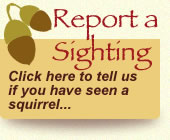Supplementary feeding
Supplementary feeding
It is important to remember that the food you provide for red squirrels should be supplementary, and not take the place of their natural food sources. Small amounts of food should be put out every 3-4 days. Hazelnuts in their shells are one of the best foods to provide, but other foods including wheat, linseed, or pine nuts are also useful. Fruits such as apples also make a welcome addition. Peanuts and sunflower seeds can be used but are of lower nutritional value. We do not recommend using peanuts exclusively. Evidence is starting to suggest that peanuts may cause liver damage in red squirrels as they can contain a substance called aflatoxin. If you do use peanuts, please make sure they are labelled as “Aflatoxin free”. A variety of food helps to relieve problems such as calcium deficiency which is particularly an issue for young squirrels. Providing bone meal, a cuttlefish bone, or even pieces of carrot can help protect against this.
 It is important not to overfeed, and all uneaten food must be removed from the feeder, not allowed to accumulate. There are many relatively inexpensive squirrel feeders on the market. If you would like to try your hand at making your own feeder, we can provide you with a template and instructions that follow an approved and tested design. Feeders and feeding sites should be located as high as possible, out of the way of cats. All feeders or feeding sites must be regularly cleaned with a disinfectant such as Virkon S or Trigene to help ensure good hygiene for squirrels, garden birds, and yourself.
It is important not to overfeed, and all uneaten food must be removed from the feeder, not allowed to accumulate. There are many relatively inexpensive squirrel feeders on the market. If you would like to try your hand at making your own feeder, we can provide you with a template and instructions that follow an approved and tested design. Feeders and feeding sites should be located as high as possible, out of the way of cats. All feeders or feeding sites must be regularly cleaned with a disinfectant such as Virkon S or Trigene to help ensure good hygiene for squirrels, garden birds, and yourself.
Be careful - providing too much food could result in artificially increasing the number of red squirrels that can be supported by the natural habitat in your area. This can lead to hardship if the supplementary food source is interrupted, for example by your summer holidays or if you move home.
You can help local red squirrels get through hard times by feeding them when natural food sources are low. One of the most important times for supplementary feeding is during the summer months; in between the availability of shoots and buds in the spring, and cones, seeds, and berries in the autumn.
Due to the threat of disease transmission, we advise that you should not carry out supplementary feeding if grey squirrels are close to where you live, and existing feeders should be removed if a grey is sighted. If your garden or feeding area is visited by a grey squirrel, please notify Red Squirrels in South Scotland immediately.
Click here for a printable version (pdf)

Please note this link will open a new window which will take you to the Scottish Wildlife Trust website where you can record your squirrel sightings.
Website by
Stewartry Technology





